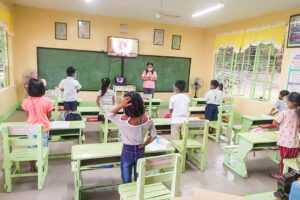By Kyle Aristophere T. Atienza, Reporter
A TRANSPORT group on Monday urged the Philippine government to increase the capacity of public transportation as the country shifts to face-to-face classes starting this month.
“We need to focus on road-based public transportation — our buses, jeepneys, UV Express and tricycles working with each sector — to restore as much capacity as possible and to make them run reliably and efficiently,” transport economist Robert Y. Siy of the Move As One Coalition said in a Facebook Messenger chat.
The government should also promote walking and cycling as a “safe and attractive” option, especially for short trips, he said.
“With inadequate public transport and high transportation inflation, spending to improve sidewalks and bike lanes in every city is one of the best investments we can make,” he said. “The government should deliver tangible results in the short to medium term while making our cities more livable.”
Traffic congestion in Metro Manila has returned to pre-pandemic levels as schools and offices resumed face-to-face operations.
Elementary and high schools will start five days of physical classes starting November, while universities will begin more face-to-face classes this month.
Mr. Siy said it is difficult to boost public transportation months before a significant increase in demand. He also cited President Ferdinand R. Marcos, Jr.’s failure to offer a solution to the transport crisis in his first address to Congress last month.
“He highlighted railways and airports,” he said. “While we need to invest in railways, especially in metropolitan areas, they require many years to complete. They are not a meaningful response to today’s emergency.”
He said the state should encourage people to walk or ride a bicycle “as millions do in many cities all over the world.” “The difference is that the best cities in the world prioritize their roads and bridges for pedestrians and cyclists.”
Mr. Siy said the government keeps “prioritizing cars on our roads and bridges, even though the vast majority of Filipinos are not car owners.” “We can improve the safety and efficiency of public transportation, walking and cycling by revising how our roads are used.”
“Not only will the new bridges move more people, they will also encourage car owners to leave their cars at home and shift to sustainable travel modes,” he added.
Meanwhile, the Passenger Forum asked the Department of Transportation (DoTR) to announce how it solves bus congestion on the main EDSA highway in the capital region.
“Three weeks have already passed since the DoTR and the Land Transportation and Franchising Regulatory Board revealed their action plan for the EDSA busway,” the group said in a statement. “We want to know if there is any progress as the situation of EDSA carousel passengers has hardly improved.”
Under the plan, the transport agencies will increase buses allowed in the EDSA bus carousel to 440 from 200.
The country loses about P3 billion daily due to the traffic congestion in Metro Manila, according to the Japan International Cooperation Agency (JICA). This could balloon to P5.4 billion by 2035, it said.

